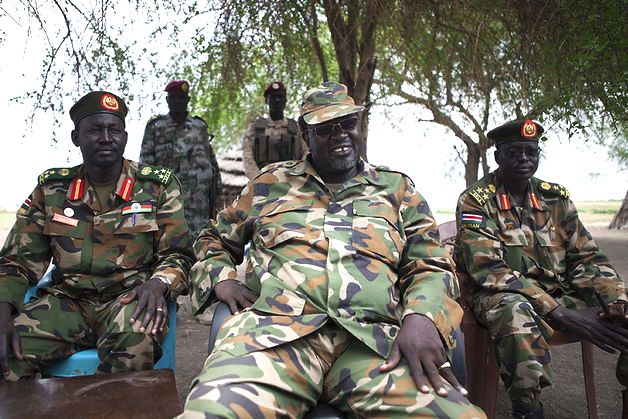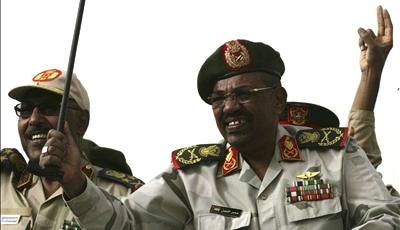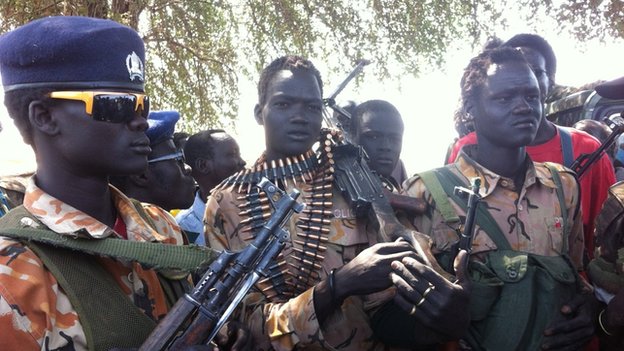Conflict Armament Research, June 2015 | DISPATCH FROM THE FIELD
WEAPONS AND AMMUNITION AIRDROPPED TO SPLA-in OPPOSITION FORCES IN SOUTH SUDAN
Equipment captured by the Sudan People’s Liberation Army in Jonglei State in November 2014
[ER—
Excerpts from this highly authoritative and amply researched report, which provides overwhelming evidence of Khartoum’s material support for the SPLA-in Opposition (SPLA-iO), follow a brief reprise of what military resources the senior security and military officials of the Khartoum regime have committed to provide to the SPLA-iO, this per a meeting of August 31, 2014. The upshot of today’s report from Conflict Armament Research is that Khartoum—through the airlifting of arms and ammunition in very substantial quantities to the SPLA-/iO—is prolonging and exacerbating the fighting in South Sudan, and making peace negotiations all the more difficult.
This serves Khartoum’s strategic purpose in weakening South Sudan by having Southerner fight Southerner—as was the case during the long civil war (1983 – 2005). The leaderships of both the Government of South Sudan and those claiming to represent the SPLA-iO have a great deal to answer for, most significantly in refusing to find a way to make peace. But Khartoum’s military support for the SPLA-iO makes this peace all the harder to achieve, and keeps in the mind of putative SPLA-iO leader Riek Machar the notion of military victory, which is impossible, but may not be fully clear as such to Riek until many more tens of thousands of Southerners have died.
Riek Machar, putative leader of the Sudan People’s Liberation Army-in Opposition
I received leaked minutes of the August 31 meeting of senior regime military and security officials in Khartoum on September 22, 2014 (the photographed Arabic original text may be found here). These minutes have now been fully confirmed as authentic, at least as far as possible without a substantiated account of the “chain of custody” for the text that came to me from a highly trusted Sudanese source. Since such an account would obviously put at great risk the lives of those who leaked these minutes, there should be no expectation of this until the present regime has been deposed.
Omar al-Bashir, the man who must be removed from power if Sudan is to have any more hopeful future; indicted by the International Criminal Court for multiples counts of genocide and crimes against humanity
I have subsequently received three additional sets of minutes whose authenticity has again been authoritatively established:
June 3, 2014 (received May 27, 2015; Arabic original text)
July 1, 2014 (received February 15, 2015; Arabic original text)
September 10, 2014 (received April 4, 2015; Arabic original text)
Not a shred of textual evidence, or contradiction of known facts, has been adduced to suggest the possibility of forgery. Indeed, Jean-Baptiste Gallopin of Yale University, besides providing an exhaustively detailed account of authenticity, has also made clear just how impossible a forgery would be in light of the time-line of events before and after the August 31 meeting.
One issue of particular concern in the August 31 meeting was a commitment by the regime to provide strategically significant quantities of weapons, as well as critical military intelligence, to the rebel forces in South Sudan, nominally the Sudan People’s Liberation Army-in Opposition (SPLA/iO) (see a fuller account at http://wp.me/p45rOG-1sZ). I focused in particular on statements by Defense Minister Abdel Rahim Mohamed Hussein:
“The people of South Sudan must accept to meet us and tell us their opinion on the drawing of the zero line and the buffer zone. If they refuse, we can deal with them in a manner that suits the threat they pose to us. I met Riek, Dhieu and Taban and they are regretting the decision to separate the South and we decided to return his house to him. He requested us to assist him and that he, has shortage in the [Military Intelligence] personnel, operations command, and tank technicians. We must use the many cards we have against the South in order to give them unforgettable lesson” (page 22 – 23 of English translation).
Defense Minister Abdel Rahim Mohamed Hussein, indicted by the International Criminal Court for massive crimes against humanity
I also noted comments by other senior military and security officials (a shake-up in the upper military ranks, reported today, has changed the title of some of these officials; see Sudan Tribune, May 2, 2015):
General Hashim Abdalla Mohammed, [former] Deputy Chief of Joint General Staff:
“We must change the balance of forces in South Sudan. Riek, Taban and Dhieu Mathok came and requested support in the areas of training in [Military Intelligence], and especially in Tanks and artillery. They requested armament also. They want to be given advanced weapons. Our reply was that we have no objection, provided that we agree on a common objective. Then we train and supply with the required weapons…”
“Now they [Riek and Taban] are fighting to achieve a federal system or self-rule for each region. I think any self-rule for Greater Upper Nile is good for us in terms of border security, oil resources, and trade. Now we have to study how to enable them [on?] a well-trained force with efficient [Military Intelligence] and logistic staff.” (page 16)
General (PSC) Imadadiin Adawi, [former] Chief of Joint Operations:
“[Juba is] still supporting the two divisions of Nuba Mountains and Blue Nile [This is simply not true in any significant sense now, if it ever was—more self-reinforcing mendacity within the regime, used as a means of explaining the crushing military defeats suffered earlier in the Nuba—ER]. Accordingly, we must provide Riek forces with big support in order to wage the war against Juba and clean the whole of Greater Upper Nile area.” (page 14)
General Siddig Amir, [former] Director of Military Intelligence and Security expressed a willingness to invade South Sudan surreptitiously :
“The South is still supporting the rebels with the aim to change our government in Khartoum. In order to counter that danger, we are pre-empting them by a plan to infiltrate and empty the refugee camps [in Unity State and Blue Nile State—ER], recruit field commanders, and train the sons of the war affected areas to fight and defeat the rebellion [by the SPLA-N—ER].” (page 11)
Vice President and General Bakri Hassan Saleh: “Recognize Dr. Riek’s liaison office and provide all organs necessary for their protection and security.” (page 28)
These were not idle threats, as revealed by the Conflict Armament Research, June 2015 | DISPATCH FROM THE FIELD. The report also works to suggest the authority of the leaked minutes of August 31.
**************************
Conflict Armament Research, June 2015 | DISPATCH FROM THE FIELD
WEAPONS AND AMMUNITION AIRDROPPED TO SPLA-in OPPOSITION FORCES IN SOUTH SUDAN: Equipment captured by the Sudan People’s Liberation Army in Jonglei State in November 2014
Fighting between the Sudan People’s Liberation Army (SPLA) and the SPLA-in Opposition (SPLA-iO) forces has been ongoing in the Greater Upper Nile region of South Sudan since December 2013. The town of Malakal in Upper Nile state repeatedly changed hands during the first three months of the crisis. On 19 March 2014, the SPLA secured Malakal and surrounding areas and maintained full control until mid-May 2015, when the SPLA-iO launched a new wave of offensives in Upper Nile State. [All emphases in bold and bold underline have been added—ER]
Each party to the conflict captured military equipment during the fighting. This Dispatch from the Field documents a sample recovered by the SPLA from SPLA-iO forces in Pigi County, Jonglei State, in November 2014. The sample, which a Conflict Armament Research (CAR) investigation team examined in SPLA Sector II Headquarters in Malakal on 11 December 2014, provides important insights into the supply of weapons to SPLA-iO forces.
Notably, the weapons and ammunition documented display clear evidence of damage sustained during airdrops to SPLA-iO units, which reportedly took place in September–October 2014. Furthermore, the materiel is identical to previously documented arms and ammunition airdropped by Sudan to rebels in South Sudan in 2012, which provides strong indication of new, direct supplies from Sudan to SPLA-iO operations.
Well armed rebel forces: how are they resupplied with weapons and ammunition in Upper Nile, Jonglei, and Unity States—far from any overland supply route?
KEY FINDINGS
Most of the ammunition documented had suffered heavy impact damage, which is consistent with eyewitness reports that aircraft dropped materiel to SPLA-iO forces in Upper Nile State in September–October 2014. [note dates that follow the August 31 meeting at which a commitment to support the SPLA-iO was made—ER]
The composition of the documented materiel, and a precedent for airdropping identical materiel to rebel forces in South Sudan in 2012, prior to the current conflict, suggests direct supply from Sudan to SPLA-iO forces.
Observers on the ground also report that, throughout the month of December 2014, aircraft dropped additional military equipment to SPLA-iO units in Upper Nile and Jonglei States.
70 per cent of the 7.62 x 39 mm ammunition documented is Sudanese-manufactured, with the majority produced in 2014. The recent date of manufacture is further evidence of direct supply from Khartoum to SPLA-iO forces.
The SPLA-iO used 2014-manufactured Sudanese ammunition prior to the September-December 2014 airdrops in Jonglei [again, following the August 31 meeting—ER]—including in its April 2014 attack on a mosque in Bentiu. This suggests more than one case of supply from Khartoum to the SPLA-iO.
All of the 7.62 x 54R mm ammunition documented is Sudanese-manufactured and dates from 2011-14. The 2011 rounds are identical to ammunition supplied by Sudan to rebel forces in South Sudan in 2012, prior to the current conflict—including in airdrops of materiel.
Chinese 12.7 x 108 mm ammunition documented is identical to ammunition supplied by Khartoum to South Sudanese rebel forces in 2012, prior to the current conflict.
The serial number of a Chinese-manufactured Type 56-1 falls within the same sequence as rifles supplied by Sudan to South Sudanese rebel forces in 2011, prior to the current conflict.
The types of materiel airdropped to support SPLA-iO operations in Jonglei State mirror weapon types that Sudan has supplied to support armed or insurgent forces elsewhere in sub-Saharan Africa, including in Darfur and the Central African Republic.
[M]uch of the ammunition inspected in Malakal, captured from the Khorflus area, was heavily damaged. Analysis of the damage indicates that many items have been crushed by a heavy impact. There is no indication (such as burning or scorching) to suggest the damage is the result of explosive blast effects. Rather, the small arms cartridges and tubes containing rockets concerned appear to have suffered lateral impact damage, which is consistent with either free-fall dropping from an aircraft or very low altitude parachute dropping.
Sudanese-manufactured cartridges comprise almost 70 per cent of the 7.62 x 39 mm sample (168 of 243). These cartridges are typical of post-2008 Sudanese manufacture and feature copper-clad steel cases, red primer seals, and triple-entry headstamps.
Nearly all (98 per cent) of them date from 2014, which indicates a very short chain of custody (11 months maximum and plausibly shorter) from production in Khartoum to delivery to SPLA-iO forces in South Sudan.



